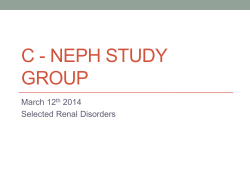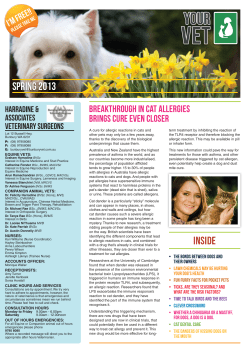
Lecture outline 9/20/2013
9/20/2013 Lecture outline Review of the Glomerulus Glomerular diseases in dogs Diagnostic approach to proteinuria Treatment recommendations for protein-losing nephropathy syndromes Susan M. Simmerson, DVM Internal Medicine Major points Proteinuria is the hallmark of glomerular disease Protein-Losing Nephropathy (PLN) and glomerular disease are synonymous Many forms of glomerular disease (PLN) are treatable Kidney biopsy is an important and feasible diagnostic test In some cases favorable prognosis is contingent upon early detection and intervention Glomerulus Functions to maintain normal oncotic pressure by inhibiting the loss of serum proteins, especially albumin, into the urine while allowing water, electrolytes and waste products to enter into the tubules for either reabsorption or excretion into the urine 400,000 - 600,000 corpuscles per kidney in the dog 1 9/20/2013 Glomerular blood flow Glomerulus – Selective Barrier Fenestrated endothelium y 34 nm diameter y Albumin ~ 36 nm Afferent arteriole Glomerular tuft Efferent arteriole Mesangial cells Basement membrane Podocytes y Contractile role to influence GFR y Negatively charged y Cover and interdigitate with each other to create slit-pores Nephrology and Urology of Small Animals. Bartges and Polzin; Wiley-Backwell 2011 http://2.bp.blogspot.com/podocyte.jpg 2 9/20/2013 Juxtaglomerular Apparatus Distinct region at the vascular pole of the glomerulus Macula densa Renal Corpuscule y Specialized epithelial cells in the Loop of Henle that detect changes in NaCl concentration in urinary filtrate y Signal Renin release from JG cells Juxtaglomerular (JG) cells y Modified smooth muscle cells around the afferent arteriole Nephrology and Urology of Small Animals. Bartges and Polzin; Wiley-Backwell 2011 Three most common forms of glomerular disease in dogs 1. 2. 3. Membranoproliferative glomerulonephritis (MPGN) Membranous nephropathy (MP) Amyloidosis Many of the glomerular diseases in dogs are believed to develop secondary to an infectious, neoplastic, or noninfectious inflammatory conditions Glomerular Diseases in Dogs Amyloidosis Focal segmental glomerulosclerosis Glomerulonephritis Crescentic (rare) Membranoproliferative Proliferative (IgA nephropathy) Glomerulosclerosis Hereditary nephritis Lupus nephritis Membranous nephropathy Minimal change glomerulopathy 3 9/20/2013 Membranoproliferative Glomerulonephritis Membranoproliferative Glomerulonephritis Accounts for up to 60% of cases of glomerular disease in dogs Rapidly progressive immunologic injury to the glomerular structure, inlcuding the mesangium, accompanied by tubular necrosis and interstitial nephritis Often fatal Primary or Secondary Antigen y Reported in association with Borrelia burgdorferi in dogs Sequella of Antigen-Antibody Deposition in the Glomerulus Activation of complement with infiltration of neutrophils, T-lymphocytes, and macrophages Glomerulus responds and releases cytokines and growth factors Platelet aggregation Activation of coagulation cascade Fibrin formation Mesangial proliferation Mesangial matrix production Inflammatory cell adhesion Increased vascular permeability Membranous Glomerulopathy Less common in dogs and less serious Antigen-Antibody deposition along the basement membrane Does not involve the mesangium Most common glomerular disease in cats 4 9/20/2013 Membranous Glomerulopathy Amyloidosis Accounts for up to ¼ of dogs with glomerular disease Results from deposition of nonfunctional protein or amyloid A Amyloid A is synthesized in the liver in response to tissue injury Underlying disease process indentified in ~ 30% of cases Poor prognosis www.unckidneycenter.org Amyloidosis Glomerulosclerosis End stage lesion in response to chronic injury Lesion associated with diabetic nephropathy y Clinical relevance in dogs is unknown stanfordhospital.org 5 9/20/2013 Hereditary Nephritis Hereditary Glomerulopathies Diverse group of inherited glomerular diseases that are a result of a genetic mutation or deletion in basement membrane collagen Soft-coated Beagle: Amyloidosis and Membranoproliferative GN y English cockers y Bull Terriers wheaten terrier: Proliferative and Sclerosing GN Shar-pei: y Dalmations Amyloidosis y Samoyeds Greyhound: Glomerular vasculopathy and necrosis Causes of Secondary Glomerulonephropathy Infectious Immune Mediated Sequella of Glomerular Damage Neoplastic Dirofilariasis SLE Leukemia Ehrlichiosis Polyarthritis Transitional cell carcinoma RMSF IMHA Lymphoma Borreliosis IMTP Bronchogenic carcinoma Septicemia Pyoderma Bartonellosis Pyometra Inflammatory Drugs IBD Glucocorticoid excess Prostatitis Trimethoprim-sulfa Hepatitis Periodontal disease Endocrine Proteinuria y Lysosomal processing of the protein in the ultrafiltrate y Toxic to tubular epithelial cells y Development of progressive azotemia y Decrease in serum albumin and systemic oncotic pressure y Systemic hypertenstion Hyperadrenocorticism Other Systemic hypertension 6 9/20/2013 Clinical Signs of Glomerular Disease Highly variable - May be most symptomatic for underlying disease Anorexia Vomiting Diarrhea PU/PD Anemia Other signs of systemic vasculitis Thromboembolism Diagnostic approach to proteinuria Nephrotic Syndrome Marked proteinuria = Hypoalbuminemia Hypercholesterolemia Peripheral edema or ascites www.vet.uga.edu Minimum Database for Proteinuric Dogs Complete blood count Serum chemistry Urinalysis Urine culture and sensitivity Urine protein:creatinine 7 9/20/2013 Localization of Proteinuria 1. Pre-Glomerular y y Proteinuria without an active UTI or other lower urinary tract disease y Dip stick vs Sulfasalicylic acid (SSA) turbidity test Glomerular 2. 3. Hemoglobinuria, myoglobinuria, fever, venous congestion Usually transient Diagnosis of PLN Urine protein:creatinine (UPC) > 0.5 ○ UPC > 1 should prompt diagnostic workup Post-Glomerular y Tubular damage, hemorrhage or inflammation of the lower urinary tract Microalbuminuria Screening for Underlying Disease Specific for albumin in the urine Can detect 1 – 30 mg/dL Microalbuminuria shown to occur before increased in UPC Tick panels y Lyme disease ○ C6 Snap or Quantitative C6 y 4DX ○ Lyme snap ○ E-canis ○ Dirofilaria ○ Anaplasma Others y Autoimmune testing (ANA, Combs, RH factor, etc) 8 9/20/2013 Imaging Chest or abdominal radiographs screening for underlying disease Abdominal ultrasound to image the kidneys Diagnosis of Glomerular Disease Kidney Biopsy y Ultrasound guided TruCut y 20 minute procedure under light anesthesia y Most of the time kidneys appear normal y In severe cases may see hyperechoic cortices or medullary rim sign Kidney Biopsy Patient selection is key y Stable patient y Non-coagulopathic patient y Controlled hypertension y Caution with severely azotemic patient Diagnosis of Glomerular Disease Kidney Biopsy ~ $500 y Definitive diagnosis y Prognostic y Guides treatment 9 9/20/2013 Texas Veterinary Renal Pathology Service Light Microscopy Texas Veterinary Renal Pathology Service Electron Microscopy Texas Veterinary Renal Pathology Service Immunofluorescence 10 9/20/2013 Treatment of Glomerular Disease Identification and elimination of causative or associated antigens Reduction of the glomerular response to injury Antiproteinuric Drugs Ace Inhibitors y Vasodilate efferent arteriol decreasing intraglomerlular pressure ○ Enalapril ○ Benazapril ○ Lisinopril y Aldosterone escape can render them ineffective Angiotensin II Receptor blockers y Directly block receptor ○ Losartan ○ Irbesartan y Aldosterone escape does not blunt RAAS blockade Treatment of Glomerular Disease Antiproteinuric drugs indicated when UPC > 2 y Creatinine < 3 mg/dL - Enalapril 0.5 mg/kg PO BID y Creatinine 3-5 mg/dL – Enalapril 0.25 mg/kg Ace Inhibitor Dosage Adjustments Minimum increase in Creat – no change in enalapril dose > 30% increase in Creat – discontinue enalapril PO BID y Creatinine > 5 mg/dL – Consider Benazepril Recheck UPC in 3-4 weeks instead 0.25-0.5 mg/kg PO q 24H Recheck serum creatinine in ~ 1 week Lees, GE, Brown SA, ElliottJ, et al. Assessment and management of proteinuria in dogs and cats: 2004 ACVIM Consensus Statement (small animal). J. Vet Int Med 2005; 19:377-385 Lees, GE, Brown SA, ElliottJ, et al. Assessment and management of proteinuria in dogs and cats: 2004 ACVIM Consensus Statement (small animal). J. Vet Int Med 2005; 19:377-385 11 9/20/2013 Ace Inhibitor Dosage Adjustments UPC > 0.5 – y increase enalapril by 0.25 mg/kg BID to a maximum of 1 mg/kg BID y Consider adjunct therapy with losartan 0.125-0.25 mg/kg BID titrated up to a maximum of 2 mg/kg BID Antihypertensives Ace inhibitors and ARB’s minimally reduce hypertension Amlodipine first line therapy y 0.1-0.4 mg/kg PO q 24H Hydralazine – refractory hypertension y Unpredictable y 0.5-2 mg/kg PO q 12H titrated to effect y Can also be given IV Lees, GE, Brown SA, ElliottJ, et al. Assessment and management of proteinuria in dogs and cats: 2004 ACVIM Consensus Statement (small animal). J. Vet Int Med 2005; 19:377-385 Antithrombotic therapy Dogs with PLN are predisposed to thromboembolism y Aspirin ○ 0.5 mg/kg PO SID-BID y Clopidogrel ○ No evidence to support it’s use ○ 3-5 mg/kg PO q 24H Omega III Fatty Acids Fish oils PO q D Antiinflammatory effect Reduces hypertriglyeceridemia and lowering systemic blood pressure in people 12 9/20/2013 Immunosuppression Controversial Indicated if the inciting cause is chronic underlying inflammation or immune mediated disease Corticosteroids administered with caution Cyclosporine has been shown to be ineffective Mycophenolate or Azathioprine anecdotally used particularly in cases of Lyme nephritis Nutritional Therapy Prescription kidney diet if they will eat it y Modified protein content y Sodium restriction Fluid Therapy in Glomerular Disease BE CAREFUL y It is very easy to fluid overload these dogs y Reduced oncotic pressure from hypoalbuminemia y Concurrent hypertension Crystalloids IV to replace dehydration deficit and ongoing losses Conservative use of colloid therapy (Hetastarch) y Consider lower sodium crystalloids Prognosis for PLN Depends upon the severity and extent of renal damage and reversibility of underlying disease If azotemia persists at the time of diagnosis, time of death for dogs in less than 3 months 13 9/20/2013 Take Home Point: Glomerular disease is common in canine patients Early recognition and treatment of disease prior to development of azotemia improves prognosis Consider a kidney biopsy – is feasible and yields useful information to guide therapy 14
© Copyright 2025



















